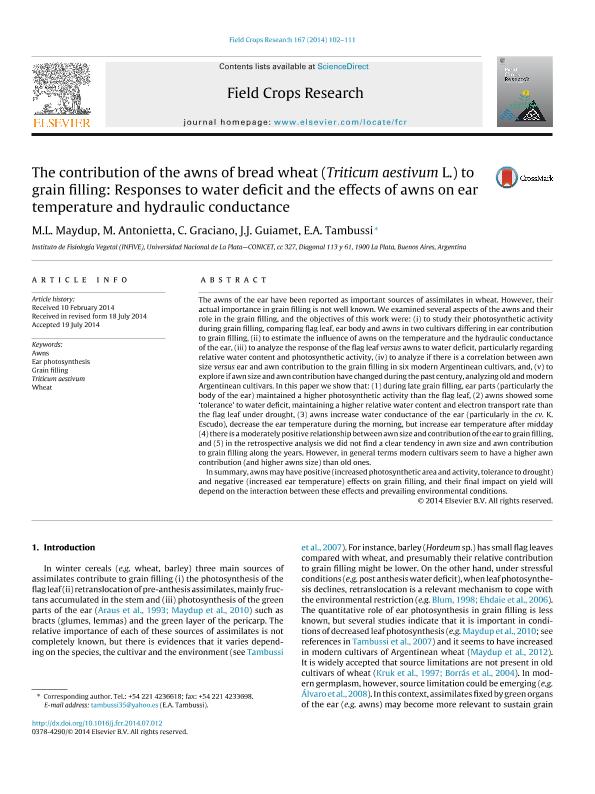Artículo
The contribution of the awns of bread wheat (Triticum aestivum L.) to grain filling: Responses to water deficit and the effects of awns on ear temperature and hydraulic conductance
Maydup, Maria Luján ; Antonietta, Mariana
; Antonietta, Mariana ; Graciano, Corina
; Graciano, Corina ; Guiamet, Juan José
; Guiamet, Juan José ; Tambussi, Eduardo Alberto
; Tambussi, Eduardo Alberto
 ; Antonietta, Mariana
; Antonietta, Mariana ; Graciano, Corina
; Graciano, Corina ; Guiamet, Juan José
; Guiamet, Juan José ; Tambussi, Eduardo Alberto
; Tambussi, Eduardo Alberto
Fecha de publicación:
08/2014
Editorial:
Elsevier Science
Revista:
Field Crops Research
ISSN:
0378-4290
Idioma:
Inglés
Tipo de recurso:
Artículo publicado
Clasificación temática:
Resumen
The awns of the ear have been reported as important sources of assimilates in wheat. However, their actual importance in grain filling is not well known. We examined several aspects of the awns and their role in the grain filling, and the objectives of this work were: (i) to study their photosynthetic activity during grain filling, comparing flag leaf, ear body and awns in two cultivars differing in ear contribution to grain filling, (ii) to estimate the influence of awns on the temperature and the hydraulic conductance of the ear, (iii) to analyze the response of the flag leaf versus awns to water deficit, particularly regarding relative water content and photosynthetic activity, (iv) to analyze if there is a correlation between awn size versus ear and awn contribution to the grain filling in six modern Argentinean cultivars, and, (v) to explore if awn size and awn contribution have changed during the past century, analyzing old and modern Argentinean cultivars. In this paper we show that: (1) during late grain filling, ear parts (particularly the body of the ear) maintained a higher photosynthetic activity than the flag leaf, (2) awns showed some ‘tolerance’ to water deficit, maintaining a higher relative water content and electron transport rate than the flag leaf under drought, (3) awns increase water conductance of the ear (particularly in the cv. K. Escudo), decrease the ear temperature during the morning, but increase ear temperature after midday (4) there is a moderately positive relationship between awn size and contribution of the ear to grain filling, and (5) in the retrospective analysis we did not find a clear tendency in awn size and awn contribution to grain filling along the years. However, in general terms modern cultivars seem to have a higher awn contribution (and higher awns size) than old ones. In summary, awns may have positive (increased photosynthetic area and activity, tolerance to drought) and negative (increased ear temperature) effects on grain filling, and their final impact on yield will depend on the interaction between these effects and prevailing environmental conditions.
Palabras clave:
Awns
,
Ear Photosynthesis
,
Grain Filling
,
Triticum Aestivum
,
Wheat
Archivos asociados
Licencia
Identificadores
Colecciones
Articulos(INFIVE)
Articulos de INST.DE FISIOLOGIA VEGETAL
Articulos de INST.DE FISIOLOGIA VEGETAL
Citación
Maydup, Maria Luján; Antonietta, Mariana; Graciano, Corina; Guiamet, Juan José; Tambussi, Eduardo Alberto; The contribution of the awns of bread wheat (Triticum aestivum L.) to grain filling: Responses to water deficit and the effects of awns on ear temperature and hydraulic conductance; Elsevier Science; Field Crops Research; 167; 8-2014; 102-111
Compartir
Altmétricas



